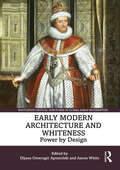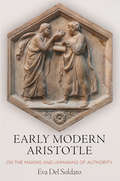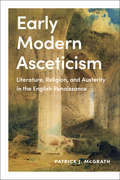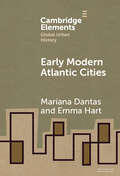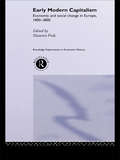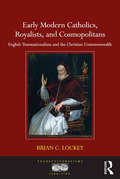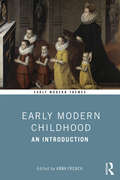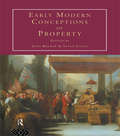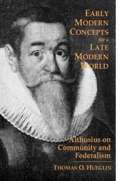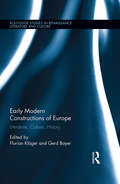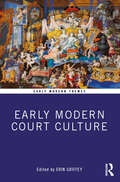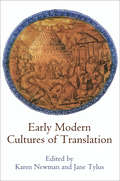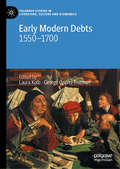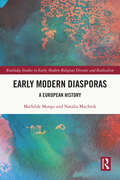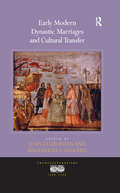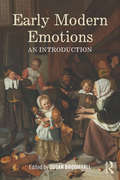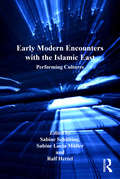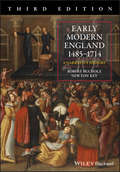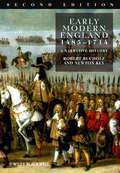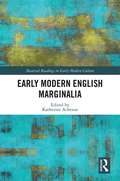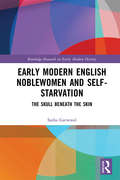- Table View
- List View
Early Modern Architecture and Whiteness: Power by Design (Routledge Critical Junctures in Global Early Modernities)
by Aaron White Dijana Omeragić ApostolskiFraming whiteness as a sensorial quality connate with ethical, aesthetic, epistemological, and ontological hierarchies, this edited volume examines how the category of whiteness shaped architectural theories and practices across the early modern period.What was architecture’s role in race-making, constructions of whiteness, and processes of othering more generally? How was whiteness architecturally questioned, reinforced, conceptualized, practiced, and materialized? And how did whiteness intersect with categories such as class, nation, gender, beauty, hygiene, and health? In examining these questions, this volume explores the ways in which premodern critical race studies allow us to reimagine the boundaries and possibilities of architectural research, design, and practice.The book will be of interest to scholars working in architectural history, art history, early modern studies, and the history of race.
Early Modern Aristotle: On the Making and Unmaking of Authority
by Eva Del SoldatoA reassessment of how the legacy of ancient philosophy functioned in early modern EuropeIn his Nicomachean Ethics, Aristotle affirms that despite his friendship with Plato, he was a better friend of the truth. With this statement, he rejected his teacher's authority, implying that the pursuit of philosophy does not entail any such obedience. Yet over the centuries Aristotle himself became the authority par excellence in the Western world, and even notorious anti-Aristotelians such as Galileo Galilei preferred to keep him as a friend rather than to contradict him openly. In Early Modern Aristotle, Eva Del Soldato contends that because the authority of Aristotle—like that of any other ancient, including Plato—was a construct, it could be tailored and customized to serve agendas that were often in direct contrast to one another, at times even in open conflict with the very tenets of Peripatetic philosophy.Arguing that recourse to the principle of authority was not merely an instrument for inculcating minds with an immutable body of knowledge, Del Soldato investigates the ways in which the authority of Aristotle was exploited in a variety of contexts. The stories the five chapters tell often develop along the same chronological lines, and reveal consistent diachronic and synchronic patterns. Each focuses on strategies of negotiation, integration and rejection of Aristotle, considering both macro-phenomena, such as the philosophical genre of the comparatio (that is, a comparison of Aristotle and Plato's lives and doctrines), and smaller-scale receptions, such as the circulation of legends, anecdotes, fictions, and rhetorical tropes ("if Aristotle were alive . . ."), all featuring Aristotle as their protagonist. Through the analysis of surprisingly neglected episodes in intellectual history, Early Modern Aristotle traces how the authority of the ancient philosopher—constantly manipulated and negotiated—shaped philosophical and scientific debate in Europe from the fifteenth century until the dawn of the Enlightenment.
Early Modern Asceticism: Literature, Religion, and Austerity in the English Renaissance
by Patrick J. McGrathIn discussions of the works of Donne, Milton, Marvell, and Bunyan, Early Modern Asceticism shows how conflicting approaches to asceticism animate depictions of sexuality, subjectivity, and embodiment in early modern literature and religion. The book challenges the perception that the Renaissance marks a decisive shift in attitudes towards the body, sex, and the self. In early modernity, self-respect was a Satanic impulse that had to be annihilated – the body was not celebrated, but beaten into subjection – and, feeling circumscribed by sexual desire, ascetics found relief in pain, solitude, and deformity. On the basis of this austerity, Early Modern Asceticism questions the ease with which scholarship often elides the early and the modern.
Early Modern Atlantic Cities (Elements in Global Urban History)
by Mariana Dantas Emma HartThe Atlantic World was an oceanic system circulating goods, people, and ideas that emerged in the late fifteenth and early sixteenth century. European imperialism was its motor, while its character derived from the interactions between peoples indigenous to Europe, the Americas, and Africa. Much of the everyday workings of this oceanic system took place in urban settings. By sustaining the connections between these disparate regions, cities and towns became essential to the transformations that occurred in this early modern era. This Element, traces the emergence of the Atlantic city as a site of contact, an agent of colonization, a central node in networks of exchange, and an arena of political contestation. Cities of the Atlantic World operated at the juncture of many of the core processes in a global history of capitalism and of rising social and racial inequality. A source of analogous experiences of division as well as unity, they helped shape the Atlantic world as a coherent geography of analysis.
Early Modern Authorship and the Editorial Tradition: Shakespeare, Donne, Herbert, and Milton (Routledge Studies in Early Modern Authorship)
by Aleida AuldThis volume adds a new dimension to authorship studies by linking the editorial tradition to the transformative reception of early modern authors and their works across time. Aleida Auld argues that the editorial tradition provides privileged access to the reception of early modern literature, informing our understanding of certain reconfigurations and sometimes helping to produce them between their time and our own. At stake are reconfigurations of oeuvre and authorship, the relationship between the author and work, the relationship between authors, and the author’s own role in establishing an editorial tradition. Ultimately, this study recognizes that the editorial tradition is a stabilizing force while asserting that it may also be a source of strange and provocative reconceptions of early modern authors and their works in the present day. Scholars and students of early modern literature will benefit from this approach to editing as a form of reception that encompasses all the editorial decisions that are necessary to ‘put forth’ a text.
Early Modern Black Diaspora Studies: A Critical Anthology
by Nicholas R. Jones Cassander L. Smith Miles P. GrierEarly Modern Black Diaspora Studies brings into conversation two fields—Early Modern Studies and Black Studies—that traditionally have had little to say to each other. This disconnect is the product of current scholarly assumptions about a lack of archival evidence that limits what we can say about those of African descent before modernity. This volume posits that the limitations are not in the archives, but in the methods we have constructed for locating and examining those archives. The essays that make up this volume offer new critical approaches to black African agency and the conceptualization of blackness in early modern literary works, historical documents, material and visual cultures, and performance culture. Ultimately, this critical anthology revises current understandings about racial discourse and the cultural contributions of black Africans in early modernity and in the present across the globe.
Early Modern Capitalism: Economic and Social Change in Europe 1400-1800 (Routledge Explorations in Economic History #Vol. 21)
by Maarten PrakThis volume takes stock of recent research on economic growth, as well as the development of capital and labour markets, during the centuries that preceded the Industrial Revolution. The book underlines the diversity in the economic experiences of early modern Europeans and suggests how this variety might be the foundation of a new conception of economic and social change.
Early Modern Catholics, Royalists, and Cosmopolitans: English Transnationalism and the Christian Commonwealth (Transculturalisms, 1400-1700)
by Brian C. LockeyEarly Modern Catholics, Royalists, and Cosmopolitans considers how the marginalized perspective of 16th-century English Catholic exiles and 17th-century English royalist exiles helped to generate a form of cosmopolitanism that was rooted in contemporary religious and national identities but also transcended those identities. Author Brian C. Lockey argues that English discourses of nationhood were in conversation with two opposing 'cosmopolitan' perspectives, one that sought to cultivate and sustain the emerging English nationalism and imperialism and another that challenged English nationhood from the perspective of those Englishmen who viewed the kingdom as one province within the larger transnational Christian commonwealth. Lockey illustrates how the latter cosmopolitan perspective, produced within two communities of exiled English subjects, separated in time by half a century, influenced fiction writers such as Sir Philip Sidney, Edmund Spenser, Anthony Munday, Sir John Harington, John Milton, and Aphra Behn. Ultimately, he shows that early modern cosmopolitans critiqued the emerging discourse of English nationhood from a traditional religious and political perspective, even as their writings eventually gave rise to later secular Enlightenment forms of cosmopolitanism.
Early Modern Childhood: An Introduction (Early Modern Themes)
by Anna FrenchEarly Modern Childhood is a detailed and accessible introduction to childhood in the early modern period, which guides students through every part of childhood from infancy to youth and places the early modern child within the broader social context of the period. Drawing on the work of recent revisionist historians, the book scrutinises traditional historiographical views of early modern childhood, challenging the idea that the concept of ‘childhood’ didn’t exist in this period and that families avoided developing strong affections for their children because of the high death rate. Instead, this book reveals a more intricately detailed character of the early modern child and how childhood was viewed and experienced. Divided into five parts, it brings together the work of historians, art historians and literary scholars to discuss a variety of themes and questions surrounding each stage of childhood, including the household, pregnancy, infancy, education, religion, gender, illness and death. Chapters are also dedicated to the topics of crime, illegitimacy and children’s clothing, providing a broad and varied lens through which to view this subject. Exploring the evolution in understanding of the early modern child, Early Modern Childhood is the ideal book for students of the early modern family, early modern childhood and early modern gender.
Early Modern Conceptions of Property (Consumption And Culture In 17th And 18th Centuries Ser.)
by John Brewer Susan StavesEarly Modern Conceptions of Property draws together distinguished academics from a variety of disciplines, including law, economics, politics, art history, social history and literature, in order to consider fundamental issues of property in the early modern period. Presenting diverse original historical and literary case studies in a sophisticated theoretical framework, it offers a challenge to conventional interpretations.
Early Modern Concepts for a Late Modern World: Althusius on Community and Federalism
by Thomas O. HueglinJohannes Althusius (1557-1638) was a political theorist and a combative city politician who defended the rights of small communities against territorial absolutism. He designed a system of politics in which sovereignty would be shared and jointly exercised by a plurality of collectivities, spatial as well as social, on the basis of mutual consent and social solidarity. Early Modern Concepts for a Late Modern World places Althusius in the context of his times and explains the main features of his political thought. It also suggests, perhaps most significantly, why his theories continue to resonate today. Hueglin's use of sources is thorough and scrupulous. He has worked in depth in Germanic scholarship and this access to German-language sources, some of which are almost unknown to the English-speaking world, provides a new interpretation of Althusius' theory. With its emphasis on pluralized governance, negotiated compromise instead of majority rule, and the inclusion of the economic sphere into the political, Althusius' theory belongs to a countertradition in Western political thought. Although it was written at the beginning of the modern age of sovereign politics, it applies to today's search for a post-sovereign system of politics.
Early Modern Constructions of Europe: Literature, Culture, History (Routledge Studies in Renaissance Literature and Culture)
by Gerd Bayer Florian KlägerBetween the medieval conception of Christendom and the political visions of modernity, ideas of Europe underwent a transformative and catalytic period that saw a cultural process of renewed self-definition or self-Europeanization. The contributors to this volume address this process, analyzing how Europe was imagined between 1450 and 1750. By whom, in which contexts, and for what purposes was Europe made into a subject of discourse? Which forms did early modern ‘Europes’ take, and what functions did they serve? Essays examine the role of factors such as religion, history, space and geography, ethnicity and alterity, patronage and dynasty, migration and education, language, translation, and narration for the ways in which Europe turned into an ‘imagined community.’ The thematic range of the volume comprises early modern texts in Arabic, English, French, German, Greek, Italian, Latin, and Spanish, including plays, poems, and narrative fiction, as well as cartography, historiography, iconography, travelogues, periodicals, and political polemics. Literary negotiations in particular foreground the creative potential, versatility, and agency that inhere in the process of Europeanization, as well as a specifically early modern attitude towards the past and tradition emblematized in the poetics of the period. There is a clear continuity between the collection’s approach to European identities and the focus of cultural and postcolonial studies on the constructed nature of collective identities at large: the chapters build on the insights produced by these fields over the past decades and apply them, from various angles, to a subject that has so far largely eluded critical attention. This volume examines what existing and well-established work on identity and alterity, hybridity and margins has to contribute to an understanding of the largely un-examined and under-theorized ‘pre-formative’ period of European identity.
Early Modern Court Culture (Early Modern Themes)
by Erin GriffeyThrough a thematic overview of court culture that connects the cultural with the political, confessional, spatial, material and performative, this volume introduces the dynamics of power and culture in the early modern European court. Exploring the period from 1500 to 1750, Early Modern Court Culture is cross-cultural and interdisciplinary, providing insights into aspects of both community and continuity at courts as well as individual identity, change and difference. Culture is presented as not merely a vehicle for court propaganda in promoting the monarch and the dynasty, but as a site for a complex range of meanings that conferred status and virtue on the patron, maker, court and the wider community of elites. The essays show that the court provided an arena for virtue and virtuosity, intellectual and social play, demonstration of moral authority and performance of social, gendered, confessional and dynastic identity. Early Modern Court Culture moves from political structures and political players to architectural forms and spatial geographies; ceremonial and ritual observances; visual and material culture; entertainment and knowledge. With 35 contributions on subjects including gardens, dress, scent, dance and tapestries, this volume is a necessary resource for all students and scholars interested in the court in early modern Europe.
Early Modern Cultures of Translation
by Jane Tylus Karen Newman"Would there have been a Renaissance without translation?" Karen Newman and Jane Tylus ask in their Introduction to this wide-ranging group of essays on the uses of translation in an era formative for the modern age. The early modern period saw cross-cultural translation on a massive scale. Humanists negotiated status by means of their literary skills as translators of culturally prestigious Greek and Latin texts, as teachers of those same languages, and as purveyors of the new technologies for the dissemination of writing. Indeed, with the emergence of new vernaculars and new literatures came a sense of the necessary interactions of languages in a moment that can truly be defined as "after Babel."As they take their starting point from a wide range of primary sources--the poems of Louise Labé, the first Catalan dictionary, early printed versions of the Ptolemy world map, the King James Bible, and Roger Williams's Key to the Language of America--the contributors to this volume provide a sense of the political, religious, and cultural stakes for translators, their patrons, and their readers. They also vividly show how the very instabilities engendered by unprecedented linguistic and technological change resulted in a far more capacious understanding of translation than what we have today.A genuinely interdisciplinary volume, Early Modern Cultures of Translation looks both east and west while at the same time telling a story that continues to the present about the slow, uncertain rise of English as a major European and, eventually, world language.Contributors: Gordon Braden, Peter Burke, Anne Coldiron, Line Cottegnies, Margaret Ferguson, Edith Grossman, Ann Rosalind Jones, Lázló Kontler, Jacques Lezra, Carla Nappi, Karen Newman, Katharina N. Piechocki, Sarah Rivett, Naomi Tadmor, Jane Tylus
Early Modern Debts: 1550–1700 (Palgrave Studies in Literature, Culture and Economics)
by George Oppitz-Trotman Laura KolbEarly Modern Debts: 1550–1700 makes an important contribution to the history of debt and credit in Europe, creating new transnational and interdisciplinary perspectives on problems of debt, credit, trust, interest, and investment in early modern societies. The collection includes essays by leading international scholars and early career researchers in the fields of economic and social history, legal history, literary criticism, and philosophy on such subjects as trust and belief; risk; institutional history; colonialism; personhood; interiority; rhetorical invention; amicable language; ethnicity and credit; household economics; service; and the history of comedy. Across the collection, the book reveals debt’s ubiquity in life and literature. It considers debt’s function as a tie between the individual and the larger group and the ways in which debts structured the home, urban life, legal systems, and linguistic and literary forms.
Early Modern Diasporas: A European History (Routledge Studies in Early Modern Religious Dissents and Radicalism)
by Mathilde Monge Natalia MuchnikThis book is the first encompassing history of diasporas in Europe between 1500 and 1800. Huguenots, Sephardim, British Catholics, Mennonites, Moriscos, Moravian Brethren, Quakers, Ashkenazim… what do these populations who roamed Europe in the sixteenth to eighteenth centuries have in common? Despite an extensive historiography of diasporas, publications have tended to focus on the history of a single diaspora. Each of these groups was part of a community whose connections crossed political, cultural as well as religious borders. Each built dynamic networks through which information, people and goods circulated. United by a memory of persecution, by an attachment to a homeland—be it real or dreamed—and by economic ties, those groups were nevertheless very diverse. As minorities, they maintained complex relationships with authorities, local inhabitants and other diasporic populations. This book investigates the tensions they experienced. Between unity and heterogeneity, between mobility and locality, between marginalization and assimilation, it attempts to reconcile global- and micro-historical approaches. The authors provide a comparative view as well as elaborate case studies for scholars, students, and the public who are interested in learning about how the social sciences and history contribute to our understanding of integration, migrations, and religious coexistence.
Early Modern Dynastic Marriages and Cultural Transfer (Transculturalisms, 1400-1700)
by Joan-Lluís Palos Magdalena S. SánchezToward the end of the fifteenth century, the Habsburg family began to rely on dynastic marriage to unite an array of territories, eventually creating an empire as had not been seen in Europe since the Romans. Other European rulers followed the Habsburgs' lead in forging ties through dynastic marriages. Because of these marriages, many more aristocrats (especially women) left their homelands to reside elsewhere. Until now, historians have viewed these unions from a primarily political viewpoint and have paid scant attention to the personal dimensions of these relocations. Separated from their family and thrust into a strange new land in which language, attire, religion, food, and cultural practices were often different, these young aristocrats were forced to conform to new customs or adapt their own customs to a new cultural setting. Early Modern Dynastic Marriages and Cultural Transfer examines these marriages as important agents of cultural transfer, emphasizing how marriages could lead to the creation of a cosmopolitan culture, common to the elites of Europe. These essays focus on the personal and domestic dimensions of early modern European court life, examining such areas as women's devotional practices, fashion, patronage, and culinary traditions.
Early Modern Emotions: An Introduction (Early Modern Themes)
by Susan BroomhallEarly Modern Emotions is a student-friendly introduction to the concepts, approaches and sources used to study emotions in early modern Europe, and to the perspectives that analysis of the history of emotions can offer early modern studies more broadly. The volume is divided into four sections that guide students through the key processes and practices employed in current research on the history of emotions. The first explains how key terms and concepts in the study of emotions relate to early modern Europe, while the second focuses on the unique ways in which emotions were conceptualized at the time. The third section introduces a range of sources and methodologies that are used to analyse early modern emotions. The final section includes a wide-ranging selection of thematic topics covering war, religion, family, politics, art, music, literature and the non-human world to show how analysis of emotions may offer new perspectives on the early modern period more broadly. Each section offers bite-sized, accessible commentaries providing students new to the history of emotions with the tools to begin their own investigations. Each entry is supported by annotated further reading recommendations pointing students to the latest research in that area and at the end of the book is a general bibliography, which provides a comprehensive list of current scholarship. This book is the perfect starting point for any student wishing to study emotions in early modern Europe.
Early Modern Encounters with the Islamic East: Performing Cultures (Transculturalisms, 1400-1700)
by Ralf Hertel Sabine Schülting Sabine Lucia MüllerAn exploration of early modern encounters between Christian Europe and the (Islamic) East from the perspective of performance studies and performativity theories, this collection focuses on the ways in which these cultural contacts were acted out on the real and metaphorical stages of theatre, literature, music, diplomacy and travel. The volume responds to the theatricalization of early modern politics, to contemporary anxieties about the tension between religious performance and belief, to the circulation of material objects in intercultural relations, and the eminent role of theatre and drama for the (re)imagination and negotiation of cultural difference. Contributors examine early modern encounters with and in the East using an innovative combination of literary and cultural theories. They stress the contingent nature of these contacts and demonstrate that they can be read as moments of potentiality in which the future of political and economic relations - as well as the players' cultural, religious and gender identities - are at stake.
Early Modern England 1485-1714: A Narrative History
by Robert Bucholz Newton KeyThe new, fully-updated edition of the popular introduction to the Tudor-Stuart period—offers fresh scholarship and improved readability. Early Modern England 1485-1714 is the market-leading introduction to the Tudor-Stuart period of English history. This accessible and engaging volume enables readers to understand the political, religious, cultural, and socio-economic forces that propelled the nation from small feudal state to preeminent world power. The authors, leading scholars and teachers in the field, have designed the text for those with little or no prior knowledge of the subject. The book’s easy-to-follow narrative explores the world the English created and inhabited between the 15th and 18th centuries. This new edition has been thoroughly updated to reflect the latest scholarship on the subject, such as Henry VIII’s role in the English Reformation and the use of gendered language by Elizabeth I. A new preface addresses the theme of periodization, while revised chapters offer fresh perspectives on proto-industrialization in England, economic developments in early modern London, merchants and adventurers in the Middle East, the popular cultural life of ordinary people, and more. Offering a lively, reader-friendly narrative of the period, this text: Offers a wide-ranging overview of two and half centuries of English history in one volume Highlights how social and cultural changes affected ordinary English people at various stages of the time period Explores how the Irish, Scots, and Welsh affected English history Features maps, charts, genealogies and illustrations throughout the text Includes access to a companion website containing online resources Early Modern England 1485-1714 is an indispensable resource for undergraduate students in early modern England courses, as well as students in related fields such as literature and Renaissance studies.
Early Modern England 1485-1714: A Narrative History
by Robert Bucholz Newton KeyThe second edition of this bestselling narrative history has been revised and expanded to reflect recent scholarship. The book traces the transformation of England during the Tudor-Stuart period, from feudal European state to a constitutional monarchy and the wealthiest and most powerful nation on Earth. Written by two leading scholars and experienced teachers of the subject, assuming no prior knowledge of British history Provides student aids such as maps, illustrations, genealogies, and glossary This edition reflects recent scholarship on Henry VIII and the Civil War Extends coverage of the Reformations, the Rump and Barebone's Parliament, Cromwellian settlement of Ireland, and the European, Scottish, and Irish contexts of the Restoration and Revolution of 1688-9 Includes a new section on women’s roles and the historiography of women and gender Accompanied by Sources and Debates in English History, 1485-1714 Click here for more discussion and debate on the authors’ blogspot: http://earlymodernengland.blogspot.com/ [Wiley disclaims all responsibility and liability for the content of any third-party websites that can be linked to from this website. Users assume sole responsibility for accessing third-party websites and the use of any content appearing on such websites. Any views expressed in such websites are the views of the authors of the content appearing on those websites and not the views of Wiley or its affiliates, nor do they in any way represent an endorsement by Wiley or its affiliates.]
Early Modern English Marginalia (Material Readings in Early Modern Culture)
by Katherine AchesonMarginalia in early modern and medieval texts – printed, handwrit- ten, drawn, scratched, colored, and pasted in – offer a glimpse of how people, as individuals and in groups, interacted with books and manu- scripts over often lengthy periods of time. <P><P>The chapters in this volume build on earlier scholarship that established marginalia as an intellec- tual method (Grafton and Jardine), as records of reading motivated by cultural, social, theological, and personal inclinations (Brayman [Hackel] and Orgel), and as practices inspired by material affordances particular to the book and the pen (Fleming and Sherman). They further the study of the practices of marginalia as a mode – a set of ways in which material opportunities and practices overlap with intellectual, social, and personal motivations to make meaning in the world. They introduce us to a set of idiosyncratic examples such as the trace marks of objects left in books, deliberately or by accident; cut-and-pasted additions to printed volumes; a marriage depicted through shared book ownership. They reveal to us in case studies the unique value of mar- ginalia as evidence of phenomena as important and diverse as religious change, authorial self-invention, and the history of the literary canon. <P><P>The chapters of this book go beyond the case study, however, and raise broad historical, cultural, and theoretical questions about the strange, marvelous, metamorphic thing we call the book, and the equally mul- tiplicitous, eccentric, and inscrutable beings who accompany them through history: readers and writers.
Early Modern English Noblewomen and Self-Starvation: The Skull Beneath the Skin
by Sasha GarwoodEarly Modern English Noblewomen and Self-Starvation: The Skull Beneath the Skin is a unique exploration of why early modern noblewomen starved themselves, how they understood their behaviour, and how it was interpreted and received by their contemporaries. The first study of its kind, the book adopts an interdisciplinary and highly detailed approach to examining women’s self-starvation between 1500 and 1640. It is also the first book to focus on this behaviour among noblewomen. Beginning with a contextual outline of gender, food and embodiment in early modern culture, the book then looks explicitly at the food behaviour of several well-known figures, including Elizabeth I, Catherine of Aragon, Mary I, Arbella Stuart, and Katherine Grey. Each case study engages with a variety of primary sources, such as letters and legal documents, as well as with literary texts, providing an in-depth exploration of the relationship between self-starvation and concepts of autonomy, sexuality, and literal and symbolic imprisonment, highlighting the body and specifically the act of eating as fundamental to identity in the early modern period and today. Employing both literary and historical methodologies, Early Modern English Noblewomen and Self-Starvation is an important contribution to the study of the history of the body and is essential reading for students and academics of early modern women’s history, gender history, food history, and the history of the body.
Early Modern Englishwomen Testing Ideas
by Paul SalzmanEarly Modern Englishwomen Testing Ideas explores how women in England participated in the considerable intellectual and cultural diversity which characterised the 'late' early modern period, from the mid-seventeenth century to the early eighteenth century. This collection looks particularly at early modern women philosophers, playwrights and novelists, and considers how they engaged with ideas and debates over philosophical and scientific ideas, as well as literary innovations. This volume extends our understanding of the philosophical ideas and literary innovations of the early modern period and presents an exciting collection of women writers vigorously engaged with the intellectual debates that were occurring in the rapidly changing post-Restoration society.
Early Modern Europe 1450-1789
by Merry E. Wiesner-HanksCovering European history from the invention of the printing press to the French Revolution, this accessible and engaging textbook offers an innovative account of people's lives, from a variety of backgrounds, in the early modern period and within the global context of European developments. Six central topics - individuals in society, politics and power, cultural and intellectual life, religion, economics and technology - are explored in two chronological sections, 1450-1600 and 1600-1789. The text takes in Europe in its entirety, eastward to the Ottoman Empire, northward to Sweden, and southward to Portugal, includes European colonies overseas, and integrates religious, ethnic, gender, class, and regional differences. Students are encouraged to think about continuities as well as changes across this formative period and throughout the text, maps, illustrations, timelines, and textboxes of original sources and featured topics illuminate the narrative. Online resources include primary source material, music examples and regularly updated bibliographies.
